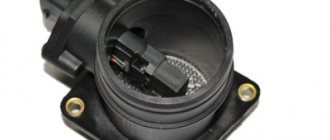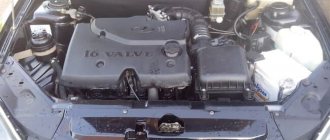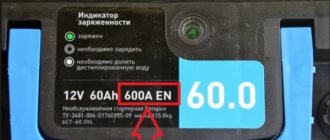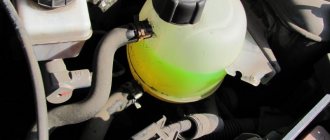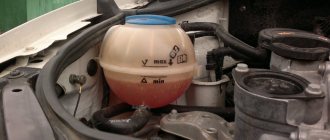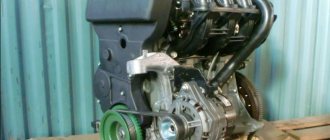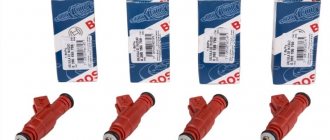Mass air flow sensor, what kind of “beast”?
The Priora air flow sensor, as its name suggests, generates the amount of air required to compose the air-fuel mixture. The air passing through the sensor is counted by a sensitive element located inside the sensor. The air flow sensor sends all measurements taken to the electronic engine control unit, which in turn adjusts the fuel and air parameters to supply the cylinders with a fuel mixture that has already been prepared for normal operation of the internal combustion engine.
Design
The mass air flow sensor consists of the following elements:
- Frame;
- Electronic element;
- Filter;
- Sensitive part;
Where is the DMRV located?
The sensor is located between the air filter and the air supply hose (pictured No. 13).
Catalog numbers of mass air flow sensor on LADA cars:
- Lada Priora, Kalina and Niva 4x4 – 21083-1130010-20.
- Lada Granta and Kalina 2 – 11180-1130010-00.
- Lada Vesta, Largus and XRAY - no mass air flow sensor. Modern VAZ engines (21127, 21129, 21179) and Renault engines (K7M and K4M) do not have a mass air flow sensor; instead, an absolute pressure sensor (APS) and an air temperature sensor (ATS) are installed.
DMRV Priora
The Priora installed two types of mass air flow sensors. The first sensors were less reliable and quickly damaged. With the transition to the E-GAZ system, more reliable and durable frequency sensors began to be installed in cars.
The external differences between the sensors are shown below:
On the left is a Priora sensor without the E-GAS system, on the right is a frequency sensor for the E-GAS system
What happens with reduced or increased air flow?
You should definitely know that air affects not only the amount of fuel burned in the engine, but also the dynamic characteristics of the car. Therefore, deviations from the above standard indicators lead to the following consequences:
- if there is less air than needed, fuel is consumed more slowly. However, at the same time, dynamic characteristics decrease and engine power decreases;
- With increasing consumption, the dynamics increase, but the fuel burns much faster.
In addition, if the deviation is 2-4 kilograms from the norm in any direction, then the power unit may go into emergency mode and begin to work incorrectly.
Symptoms of a problem
Since the sensor is electronic and if it fails, the “CheckEngine” lamp will necessarily light up on the car’s dashboard. But not in all cases the sensor fails completely. When the sensor is dirty or old, it begins to incorrectly read the air volume, which significantly affects the formation of the air-fuel mixture.
In case of such a breakdown, the “CheckEngine” warning light will not light up.
Signs:
- Engine speed fluctuates;
- Difficulty starting in all temperature conditions of the internal combustion engine;
- Increased fuel consumption;
- Uneven engine operation at idle;
- Loss of vehicle dynamics;
If you find such malfunctions on your car, first of all you need to inspect the air flow sensor.
Signs of a malfunction of the mass air flow sensor on Priora and Kalina
The first and main sign of a flow meter failure is increased gasoline consumption. When the sensor stops working normally, the engine on Priora and Kalina begins to consume a minimum of 13 liters, a maximum of 16-18 l/100 km. This may also be accompanied by either unstable idle speed or consistently high speed. The third sign is a sharp drop in power when driving, the car begins to “kick” or accelerate slowly.
Indirect signs of DMRV malfunctions:
- increased CO2 levels;
- gray exhaust, black velvet carbon deposits on all spark plugs;
- If you suddenly release the gas pedal while driving, the engine will stall.
Examination
Checking the mass air flow sensor is carried out using a multimeter, diagnostic tool or oscilloscope. In most cases, car enthusiasts do not have equipment that can diagnose sensor failure.
In this case, let's consider checking with a regular multimeter, which almost every driver has or is otherwise inexpensive.
Checking the mass air flow sensor with a multimeter can only be done with a sensor that is installed on an engine without an E-GAS system. The frequency sensor installed in conjunction with the electronic throttle cannot be checked using a multimeter. Checking such a sensor is carried out with a diagnostic device using ADC channels or using a diagram on an oscilloscope.
You can also check the frequency sensor using the ELM327 diagnostic tool; read how to do this in our article.
Verification Process
To check the sensor you will need two needles and a multimeter. The principle of determining the performance of the mass air flow sensor is carried out by measuring the voltage between the contacts.
Checking the circuit
Initially, the sensor's power circuit is checked.
- We switch the multimeter to the DC voltage measuring mode at 20V.
- Remove the connector from the mass air flow sensor.
- Turn on the ignition on the car.
- We connect one of the multimeter leads to the motor housing, and the second to Pin No. 2 on the connector (there is a numbering of contacts on the block). The voltage at Pin No. 2 must be at least 12V.
- We carry out the same procedure with Conclusion No. 4. The voltage at Pin No. 4 must be at least 5V.
If the readings do not match and are significantly less than those indicated, you should check the battery, computer and power supply circuit of the mass air flow sensor.
Sensor check
Let's start checking the sensor; to do this, connect the mass air flow sensor connector if it is removed.
- We set the DC voltage measurement limit on the multimeter to 2V or 2000mV (in different versions of the multimeter, this value is indicated differently).
- We measure the voltage between terminals 1 and 3 with the car ignition on and off. We check the readings with the table below.
| Voltage (V) | State |
| 0.99…1.01 | Condition of the new sensor |
| 1.01…1.02 | The sensor is in good condition |
| 1.02…1.03 | Normal state of the air flow sensor |
| 1.03…1.04 | Needs replacement soon |
| 1.04…1.05 | The sensor practically does not work, it needs replacement |
| 1.05...and higher | The sensor is completely faulty and urgently needs replacement |
Also, one of the good checks of the mass air flow sensor is to replace it with a known good one, for example from another similar car.
Checking the performance and replacing the air flow sensor of the LADA Granta
The injection engine control system uses data from many sensors to form the optimal composition of the fuel mixture. One of them is the mass air flow sensor (MAF LADA Granta). Like any car part, the sensor can fail and cause errors in the operation of the injection system. Therefore, the mass air flow sensor must be changed immediately when signs of malfunction appear.
Design and principle of operation of the LADA Granta mass air flow sensor
The purpose of the mass air flow sensor is to control the amount of air flowing from the air filter into the engine. The LADA Granta mass air flow sensor is installed on the pipe between the throttle valve and the filter and measures the flow speed in a simple and original way: by monitoring the cooling of the electrical conductor. The mass air flow sensor has two platinum filaments through which current passes. The first thread is cooled by the air flow passing from the filter, the second is a control thread. By cooling the first thread, the resistance decreases in proportion to the strength of the air flow. Accordingly, the engine ECU receives information about the amount of incoming air and can ensure the optimal ratio of the components of the air-fuel mixture supplied to the combustion chambers.
Signs of malfunction of the LADA Granta mass air flow sensor
The simplest and most noticeable sign that there are problems with the mass air flow sensor is the “CHECK ENGINE” light on the panel and the corresponding error code of the on-board computer. The following signs also indicate a malfunction of the mass air flow sensor:
- unstable, high or low idle speed;
- increased gasoline consumption;
- weakened engine dynamics and power;
- problems with starting the engine, especially when it is hot.
The listed signs do not necessarily indicate a breakdown of this particular part, however, if they appear, it is necessary to check the LADA Granta mass air flow sensor. If the check confirms the breakdown, it must be replaced.
Tip: The mass air flow sensor may not work properly if the air pipe is damaged, so before checking the sensor, you should make sure there are no cracks or breaks in the pipe.
How to check the MAF of the LADA “Granta”
It is possible to absolutely accurately assess the performance of the mass air flow sensor only if you have special expensive equipment (motor tester). However, there are three simple and reliable methods: visual inspection, disconnecting the sensor and checking with a multimeter. Visual inspection of the mass air flow sensor allows you to “by eye” assess the serviceability of the part. To inspect the sensor, you need to loosen the air pipe clamp and remove the latter. The inner surface of the corrugation and the mass air flow sensor must be clean, without signs of oil deposits. You should also make sure that the corrugation is not damaged and does not “suck” air past the air filter and sensor. The next stage of inspection is removing and checking the sensor itself. To do this, you need to unscrew the two mounting bolts and remove the sensor from the filter housing along with the sealing ring. The inlet grid of the mass flow sensor must be free of dust or oil.
If the mesh is dirty, you can try to simply clean it without changing the sensor. When visually inspecting the mass air flow sensor, you should pay attention to the condition of the sealing ring. Often the sensor does not work due to air leaks through a damaged or worn rubber seal ring
Disabling the mass air flow sensor is the fastest and easiest way to check its performance. It is necessary to remove the connector from the sensor and start the Granta engine and make a test drive. The engine controller will automatically go into emergency mode and the proportions of the fuel mixture will depend only on the position of the throttle valve. If a test drive shows that acceleration dynamics improve with the mass air flow sensor turned off, it is necessary to replace the sensor with a new one.
Checking the mass air flow sensor using a multimeter is only relevant for some Bosch sensors. It is necessary to measure the voltage at the sensor with the engine not running (between the yellow and green wires). If the voltage is within 1.01-1.02 volts, the sensor is working. voltage above 1.05 volts indicates a failure of the mass air flow sensor.
How to change the air flow sensor of a LADA “Granta”
The mass air flow sensor cannot be repaired and if it malfunctions, it must be replaced with a new one. Replacing the MAF sensor of the LADA “Granta” is performed as follows:
- Unscrew the clamp with a screwdriver;
- disconnect the connector from the mass air flow sensor;
- Using a 10mm wrench, unscrew the two MAF mounting bolts;
- pull out the sensor with the seal from the air filter housing;
- install a new sensor with an o-ring;
- screw in and tighten the sensor mounting bolts;
- connect the connector.
The MAF sensor has been replaced; all that remains is to check its operation by performing a test start of the engine and a drive.
Replacement
- Remove the negative terminal from the battery.
- Remove the connector from the mass air flow sensor.
- Unscrew the intake corrugation clamp from the sensor.
- Unscrew the two 10mm wrench bolts.
- We take out the sensor and install a new one in the reverse order.
- Don’t forget to remove the rubber ring from the old sensor and install it on the new one.
Determining the malfunction of the mass air flow sensor
There are various breakdowns in the Priora mass air flow sensor. To understand that the mass air flow sensor is faulty, you need to check it using the Check Engine lamp, or a multitester designed for testing. If you are shown error codes 34 or 33, then the mass air flow sensor has a malfunction. This means you need to check the motor. Another evidence of a malfunction of your mass air flow sensor in Priora is an increase in fuel consumption. If your engine does not start well, this may also indicate a problem with the mass air flow sensor.
If you notice poor acceleration dynamics, the car begins to brake sharply and accelerate sharply, then this also serves as a signal that your sensor is broken. Interruptions in engine operation and jumps in speed also indicate this. If the car stops the engine when changing gears, then you should check the sensor.
The engine crankcase ventilation system has its own characteristics. It has two circuits installed. The first one is large, it starts working when the throttle valve is open. The second is small, works in idle mode, when the throttle is closed. During operation with the throttle closed, crankcase gases enter the throttle space.
And some of them touch the film resistor of the mass flow sensor. The deposited resins begin to change the characteristics of this resistor, so the sensor begins to fake. In this regard, the idle speed controller also begins to malfunction, this affects the engine starting. The mass air flow sensor becomes faulty. A common problem with the sensor is contamination of the coil. They can be cleaned using carburetor cleaner, but this must be done carefully.
Checking the regulator for functionality
To diagnose the condition of the flow meter, you must first unscrew the clamp that secures the air intake corrugation; for this you will need a Phillips screwdriver. Carefully remove the line itself, and then perform a visual diagnosis of its surfaces. The internal cavities of the pipe must be clean; condensation or moisture is not allowed. If the air filter in your car is not changed in a timely manner, this can also negatively affect the functionality of the flow meter, since it can become clogged with dust.
Using a 10mm wrench, you need to unscrew the flowmeter fixing elements. Once you have the regulator in your hands, you need to inspect it. The rubberized seal should be located at the edge of the outlet; if it has moved, it needs to be corrected. If you do not do this, then over time the flow meter will stop working due to dust getting inside.
Diagnostics of the sensor with a multimeter proceeds as follows:
- The tester sets the voltage level to 20 volts.
- Two wires should be connected to the sensor holes, after which the tester probes are connected to it. When you turn on the ignition, the tester should show a number between 0.99 and 1.00. If these numbers are 1.01 or 1.02, up to 1.03, then the condition of the flow meter is generally satisfactory, it can still be used. If the readings are higher, then the device needs to be changed.
